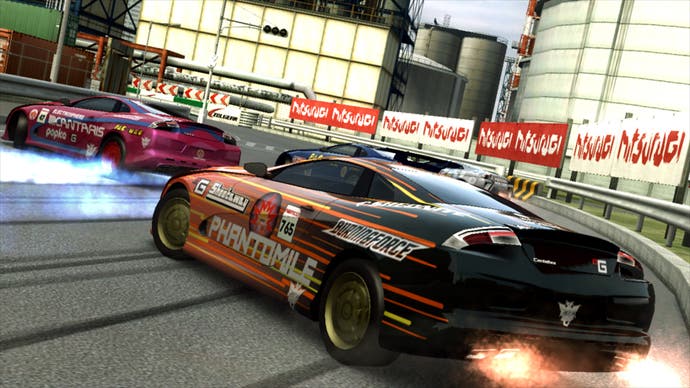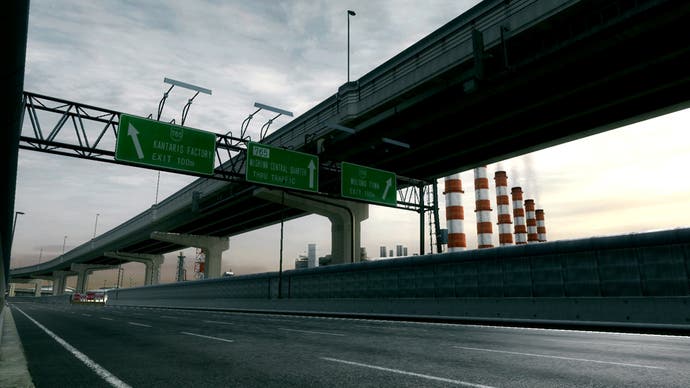Ridge Racer 7
Flaw it!
Dear Namco,
DIFFICULTY LEVELS, DORKFACE!
Signed, me.
Anyway. Probably the best way to start this review is to simulate the experience of playing Ridge Racer 7. Bear in mind that, for the next few paragraphs, you will be the subject of my whim. You are a rat in a cage of my design. HAHAHA. Continue.
Ridge Racer 7 is ostensibly Ridge Racer 6 with a few important changes. But for all its dalliances with nitrous, slipstreaming, customisation and 1080p, the reason we're all here is still the same: boosted starts, ludicrous tracks, and zooming around hairpins at 200mph, wiggling the stick efficiently as you do to preserve as much speed as possible.
Cornering has always been Ridge Racer's unique attribute. It turns the traditional set-up on its head in favour of "drifting". Instead of slowing to go into a corner, you want to be going as fast as possible. The challenge isn't finding the right line into one (although it helps); it's trying to avoid bashing anybody who's doing it at the same time as you, despite the fact that drifting has spun you both almost sideways, and then making sure that you don't overcompensate on the way out of the turn. If you do, you'll bang into the wall or another car and bounce off repeatedly - the manner of bouncing so completely stupid that you'll wonder if Namco's ever played any other racing games in its life.
If anything, this emphasis on spectacular cornering has only grown as the series has progressed. Namco has introduced more drift types - standard cars swerve around quite a lot, but usually only go into a drift if you make them, and click helpfully back to the racing line when you finish; mild cars swerve much less, and generally grip the road far more; while dynamic cars will go into a drift if the wind changes (or, more accurately, if you steer hard in one direction), and require a lot more talent to manoeuvre effectively.

(You're still a rat, by the way. Keep going.)
Meanwhile the PSP version saw the introduction of nitrous, which is a means of boosting to increase top speed, with the nitrous "tanks" filled by drifting around corners as fast as possible. The clever bit was (and is) that you can't fill the tanks while nitrous is engaged, but, if a tank empties as you approach a corner and you immediately drift, some of the residual nitrous effect will see you cornering at greater than your usual top-speed and the empty tanks will refill more quickly as a result. The Xbox 360 Ridge Racer 6 refined this, allowing you to daisy-chain your three nitrous tanks into one long, even greater burst of speed, called "Ultimate Charge".
The other thing that the PSP versions and Ridge Racer 6 have in common is the enormous amount of races available to take part in.
And it's with the help of that sentence that you may now exit the cage (mind your tail) and join me back here in the heartland of the review, because the other thing about the PSP and 360 games' "enormous amount of races" is that, for anybody capable of pushing buttons without falling off the sofa and setting fire to their hair, the first few hours' worth were almost intolerably boring and trivial. They don't care if you already know the basics; you're going to have to sit through them again anyway, and before you know it you're bored out of your mind and just wish they'd get to the sodding point.

Which is roughly the effect I was going for. Of course you know what drifting is, and how nitrous works. Indeed, there's very little chance you haven't played Ridge Racer before (although if you haven't you should buy this, the 360 game or one of the PSP versions and come back when you hate Angelus), and if you have then you're bored of what I'm saying. And so you will be in the game for quite some time.
Well, that's not entirely fair. You will find novelty in a few of the early hours. For instance, you'll be playing the game in 1080p. Well, you might be. Either way, you'll be playing spot the difference, hoping to contribute to those exciting forum threads about whether the leaves are slightly browner than they were on Xbox 360 and whether this means the war is over. In truth, what you'll find is that RR6 looks smoother, and also seems to have a slightly richer colour-depth, but that RR7 also does some effects that RR6 hasn't (soft street-lamp reflections in wet surfaces, most noticeably), while looking slightly brighter on some tracks and, of course, filling your eyes with 2,073,600 pixels rather than 921,600. Most of the time though, it's hard to tell which is which at a glance - the only truly tell-tale bits being the rear-view mirror at the top of the PS3 screen, which is operating at a slightly lower detail level than the main game graphics (unlike RR6's), and, you know, the extra million-and-a-bit pixels, which are neither here nor there unless you're on a crusade, in which case fill your boots.
So there's that to occupy yourself with, but more interesting to Ridge devotees will be the differences in modes, the new tracks, and the roles of slipstreaming and customisation.

Customisation is really the key improvement. As you complete races in single-player, you earn credits and the right to buy parts from certain manufacturers. These not only allow you to change the look of your car (take it or leave it) and increase its top-speed by upgrading the engine and so on, but more interestingly they also allow you to customise the drift and nitrous characteristics, and introduce "plug-in units". Some tyres will allow you to amplify the dynamic drift attribute, for example, while nitrous kits allow you to change how they charge. Reverse-nitrous only fills tanks while nitrous is being used (which, applied frivolously, means you can be left without the ability to accumulate nitrous at all); flex-nitrous is only active when you hold down the nitrous button, rather than emptying an entire tank every time you do; auto-charge fills your tanks up to a maximum of four (although you can only use three at once), automatically rather than when you're cornering, giving you a new source of boost every 12 seconds or so. There are also other variants that change the potency of single, double or triple nitrous charges - giving you a higher top-speed for Ultimate Charge, for example, but at the expense of strength in single and double charges.


